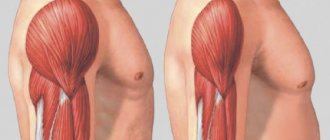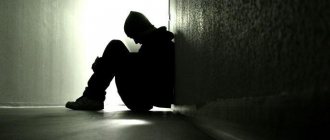Neuroleptics reduce the sensitivity of receptors (sensitive cells) that interact with dopamine. Presumably it is this mechanism that provides their antipsychotic effect. In addition, blockade of dopaminergic structures in the subcortical region leads to the development of extrapyramidal disorders. Inhibition of noradrenergic receptors is manifested by an increase in sedative effect. Blockade of dopamine receptors in the pituitary gland and hypothalamus leads to hormonal imbalance: the secretion of prolactin increases, lactation is stimulated, and the production of growth hormone and adrenocorticotropic hormone is inhibited.
Effect on the body
The main pharmacological feature of antipsychotics is their antipsychotic sedative effect. It manifests itself in relaxation, restoration of emotional balance, and decreased excitability. In patients with psychotic disorders, hallucinations, automatisms, and delusional ideas fade away.
Antipsychotics do not have a pronounced hypnotic effect, but they can provoke a drowsy state, facilitate the onset of sleep, and increase the effectiveness of sedatives. Therefore, for example, the combination of “barbiturates + neuroleptics” causes excessive sedation and hypotension. The effect of analgesics and local anesthetics is also enhanced, but the effects of psychostimulants are reduced.
There are groups of antipsychotics with specific effects. Thus, aliphatic phenothiazine derivatives, for example, Aminazine, have a sedative effect, and piperazine phenothiazine derivatives (Prochlorperazine) have an activating effect. Some antipsychotics ease depression, reduce anxiety, and increase appetite.
Side effects of antipsychotics and compatibility with other substances
In certain cases, it is possible to take antipsychotic drugs together with other drugs, such as selective serotonin and norepinephrine reuptake inhibitors, lithium or other therapeutic tranquilizers.
According to research, the combined use of tranquilizers, hashish or other types of narcotic substances is contraindicated, due to the manifestation of negative results, resulting in a decrease in the effectiveness of treatment. Moreover, exacerbation of psychosis, schizophrenia and other mental disorders may occur.
Indications for use
Antipsychotics are prescribed for mental and psychoneurological disorders accompanied by delusions, hallucinations, pseudohallucinations, illusions, thinking disorders, behavioral disorders, psychotic agitation, aggressiveness, and mania.
Sometimes these drugs are effective in treating depression, deficiency symptoms - pathological lack of will, apathy, emotional flattening, autism. A number of studies point to the fact that antipsychotics eliminate deficit symptoms by reducing delusions, hallucinations, or depression. The most common indications for the prescription of antipsychotics are diseases such as:
- schizophrenia
- bipolar affective disorder
- dementia with behavioral disturbances
- exogenous psychoses (alcoholic, stimulant)
- behavior disorders of excitable, hysterical type
- neurotic, neurosis-like disorders (in small dosages)
Atypical antipsychotics: mechanism of action
Regardless of classification, all antipsychotics interact with dopamine, a hormone synthesized by neurons. Drugs change its activity, acting selectively. Therefore, the side effects from taking them are not so pronounced and are rarely accompanied by neurological disorders. In addition, such medications, with the exception of a few drugs, block serotonin receptors, eliminating negative symptoms such as depression and other types of emotional flattening.
Call for a free consultation with a narcologist +7 (495) 648-66-16
Pharmacological effect
Atypical antipsychotics (neuroleptics) contribute to a progressive increase in psychotic symptoms and reduce the risk of relapse of the disease.
A) Therapy of psychosis.
The effectiveness of the use of new generation antipsychotic drugs is very high in the treatment of hallucinatory-delusional states. The positive effect of the drugs is felt after just a few days of taking them. After about two weeks, the symptoms of the disease completely disappear. If classical first-generation drugs block all psychotic manifestations, then modern substances act selectively. An example is Risperidone, which only relieves delirium.
B) Reduction of negative symptoms.
Negative symptoms of mental illness mean weakening, loss of any functions, which can be expressed in decreased intelligence, permanent or temporary amnesia, depression or apathy. Studies of the effect of antipsychotics on the human body have shown that this group of drugs reduces the risk of developing negative symptoms. At the same time, the mental functions of the central nervous system are preserved. For example, a patient with schizophrenia ceases to suffer from movement disorders and depression. He becomes socially and mentally active.
C) Elimination of depression.
Some atypical psychotropic drugs have antidepressant properties. They block serotonin receptors, which support hemostasis. As a result, its concentration in the blood increases. And, as you know, a lack of neurotransmitter causes depression. Among these antidepressants are Aripiprazole and Clozapine. But it is worth pointing out that among antipsychotics there are many that increase the concentration of the hormone prolactin, which causes the development of anxiety, depression and aggression. Patients using atypical antipsychotics in treatment rarely suffer from hyperprolactinemia, while “old” first-generation drugs cause complications in the form of disturbances in sleep and wakefulness, irritability, and bad mood.
D) Reducing the likelihood of relapse.
Using new antipsychotic drugs, it is possible to achieve a significant reduction in the frequency of relapses of acute psychoses. The list of the most effective drugs includes Amisulpride, Olanzapine, Clozapine. This property is due to the minimal side effects of drugs. While first-generation pharmacological substances produce severe side effects and the patient more often violates the treatment regimen, which leads to the reappearance of symptoms of the disease.
D) Drowsiness.
Medicines that eliminate insomnia and relieve attacks of anxiety and irritability belong to the group of sedatives. The most effective in this regard is the atypical antipsychotic Clozapine. In cases where it is necessary to eliminate drowsiness, Sertindole is used.
Side effects of atypical antipsychotics
Modern antipsychotics are safer than their predecessors. Their use rarely leads to movement disorders. For example, to tremor of the limbs, head, dystonia or akathisia. However, it is worth knowing that taking drugs in large doses increases the likelihood of developing these pathologies. Other types of side effects of atypical psychotropics include:
- hyperprolactinemia, that is, excessive synthesis of prolactin;
- metabolic disorders. Can be expressed in the form of diabetes, obesity and other metabolic disorders in the body;
- pathologies of the cardiovascular system;
- anticholinergic symptoms. For example, intestinal obstruction, visual accommodation disturbances, heart rhythm disorder.
Side effects can be avoided by following doctor's orders and medication schedules. In some cases, it will be necessary to replace one antipsychotic with another.
Types of antipsychotic drugs
There are several classification options for antipsychotics. In clinical practice, the most common division of drugs is based on their leading action. There are three groups of antipsychotics:
- Sedatives. They have a predominantly sedative effect: they inhibit mental processes, eliminate anxiety, restore sound sleep, and relax skeletal muscles. Ineffective for delusions and hallucinations. This group includes Aminazine, Clozapine, Promazine.
- Antipsychotic. The main effect is a decrease in productive psychotic symptoms (delusions, hallucinations, motor, mental agitation). Neurological side effects are typical. Some of the drugs in this group have an additional sedative effect, while others, on the contrary, activate and increase disinhibition (the so-called “daytime” neuroleptics). Representatives - Haloperidol, Etaperazine, Droperidol, Sulpiride.
- Behavior correctors. As the name implies, the ability of drugs to stop behavioral disorders of the excitable, hysterical type comes to the fore. Prescribed for severe psychopathy and neuroses. When they are used, there is a decrease in temperament, demonstrativeness, and aggressiveness. This group includes: Periciazine, Thioridazine (Sonapax).
Typical and atypical antipsychotics
Typical or classical antipsychotic drugs are called the first generation of antipsychotics. They have a high degree of affinity for dopamine D receptors and do not bind to receptors of other types. They have a pronounced antipsychotic effect and a high risk of developing extrapyramidal disorders. Typical antipsychotics are Chlorpromazine, Alimemazine, Periciazine.
Atypical antipsychotics are new generation drugs that have a low degree of affinity for dopamine D2 receptors and are able to bind to other receptors (serotonin, norepinephrine). They are “milder” and better tolerated, but, according to some researchers, they are less effective against negative psychotic symptoms. Atypical antipsychotics – Clozapine, Olanzapine, Risperidone, Asenaline.
Types of neuroleptic therapy
- Neuroleptic therapy is possible in an active form: administration through injections and infusions (used to quickly achieve an effect using small doses).
- Inactive antipsychotic therapy is the most common type of treatment: drugs are taken in tablet form according to the regimen prescribed by the doctor. Used to treat conditions that are not severe and do not require a quick effect, to maintain remission.
- Depot therapy. The antipsychotic drug is given as an injection (usually oil-based for slow release). The injection is given once every 2-4 weeks, ensuring a constant supply of the drug to the body. A convenient form of treatment that allows you not to constantly monitor the patient (whether you took the medicine or not, forgot or didn’t forget).
Features of treatment of schizophrenia
According to modern requirements, treatment of schizophrenia includes three subsequent stages:
- Relieving or active therapy – aimed at quickly eliminating delusions and hallucinations. Duration – 4-12 weeks. Typical antipsychotic drugs are usually used.
- Aftercare, stabilizing or maintenance therapy – stabilization of the patient’s condition, elimination of depressed mood, normalization of interest in life, memory and mental processes. Duration – 3-9 months. Atypical antipsychotics are usually used.
- Anti-relapse or preventive therapy – preventing the development of new attacks and slowing down the rate of deterioration of the disease. Duration is indefinite, but not less than 1-2 years. Atypical antipsychotics are usually used.
With prolonged use of antipsychotic drugs, addiction develops to them (decreased effect), and depression may develop.
For the practical use of antipsychotics, two proven principles of their division are used: according to chemical structure and according to the so-called antipsychotic potential. The latter term refers to the intensity of the antipsychotic action of a neuroleptic, which was previously considered in conjunction with extrapyramidal movement disorders caused by these drugs. At the same time, per def nition, the action of chlorpromazine was assigned a neuroleptic potential of I. Despite the fact that the creation of new groups of drugs with “antipsychotic” action that do not cause extrapyramidal motor symptoms has greatly changed the theoretical ideas about the mechanisms of action of neuroleptics, knowledge of the main indicators of neuroleptic potential allows us to understand what action and what possible side effects should be expected when prescribing certain drugs. The basic rule states that when using antipsychotics with a low potential level, the degree of severity of the anticholinergic effect goes in parallel with the sedative neuroleptic effect and, conversely, “high-potential antipsychotics cause extrapyramidal motor symptoms to a greater extent and, to a lesser extent, autonomic disorders.
Based on their chemical structure, antipsychotics can be divided into four groups:
- tricyclic antipsychotics (mainly Phenothiazin and Thioxanten); - butyrophenoc derivatives;
— rawolfia alkaloids;
- other neuroleptics.
In clinical practice, the first place belongs to derivatives of phenothiazines and butyrophenones. Rauwolfia alkaloids are currently almost never used. Among the antipsychotics belonging to other groups of chemical compounds, Sulpirid (Dogmatil) and Clozapine (Leponex) should be mentioned first of all. The latter, due to its toxic side effects (can cause agranulocytosis), should be prescribed only for very strictly individual indications. The number of antipsychotics on the market is so large that even a specialist finds it difficult to navigate their diversity. Therefore, for personal practice and, especially, in individual clinics, it is recommended to adhere to a certain choice that satisfies all the goals. This tactic is also justified because the neuroleptic effect of both chemical groups differs from each other not so much qualitatively as quantitatively. At the same time, side effects can be significantly differentiated. It is the side effects that ultimately determine whether the patient should continue taking the prescribed drug after discharge from the clinic.
Target syndromes in treatment with neuroleptics.
In previous years, many efforts were made to find a specific drug for a specific patient. Unfortunately, all these searches were carried out by trial and error. As a first approximation, one can focus on the “target symptom”, which is in the foreground of the patient’s psychotic experiences and behavior. Weakening and alleviation of symptoms is most often achieved with low-potency neuroleptics, and acute, productive-hallucinatory syndromes with thought disorders dictate the use of high-potency drugs. The diagram below clarifies this position. In states of excitement associated with delusional ideas and fears, physically healthy adults are recommended to prescribe 10 mg Haldol (2 amps of 1 ml), which has fully justified itself. If this is not enough, then you can prescribe an additional 5-10 mg of Valium (1-2 amps). In this way, it is almost always possible to calm the patient and relieve tension. Often, after such medication, patients fall asleep for a short time (in this case, it is necessary to strictly monitor the state of blood circulation!).
Therapy of schizophrenic diseases. – previous | next – Side effects of antipsychotics.
PSYCHIATRY. PSYCHOSOMATICS. PSYCHOTHERAPY. Table of contents.
Contraindications
Antipsychotics should not be taken simultaneously with alcoholic beverages. Some drugs should not be used during pregnancy and lactation, or for people with acute heart, kidney or liver diseases. Each drug has its own list of contraindications. In this regard, the over-the-counter sale of antipsychotics is strictly prohibited.
Ambulatory treatment
Basics of treatment for schizophrenia
Treatment of schizophrenia is a long, often lifelong, process.
All antipsychotic drugs have a large number of side effects, so they are prescription drugs. Antipsychotic drugs are prescribed by a psychiatrist, taking into account the manifestations of the disease, the patient’s age, and the presence of other diseases.
Initially, the patient is prescribed typical antipsychotic drugs - they have a powerful antipsychotic effect, but also a large number of side effects. Next, the patient is transferred to atypical antipsychotics - drugs with a moderate antipsychotic effect, but safer in terms of side effects. An additional benefit of atypical antipsychotics is their beneficial effects on memory and mental processes, as well as mood in patients with schizophrenia.
Consequences of neuroleptics
Self-administration of tranquilizers leads to the development of severe mental syndromes. As a result of prolonged, uncontrolled and excessive use of antipsychotics, mental retardation, loss of memory, and intellectual functions develop; Severe pathologies of the liver, brain, and central nervous system develop.
Group classes in
Neuroleptics and alcohol
Taking alcohol together with tranquilizers leads to complications such as poisoning leading to coma, toxic liver damage, psychosis, and even sudden cardiac arrest.
Antipsychotic drug poisoning
There are several symptoms of antipsychotic poisoning:
- Nausea, vomiting;
- Severe weakness and dizziness;
- Dry mouth;
- Ataxia;
- Impaired reflexes and reactions;
- Decreased or absent reaction to light;
- Loss of consciousness;
- Pulse depression;
- Reduced blood pressure;
- Convulsive attacks, foaming at the mouth.
If symptoms of poisoning appear, seek immediate medical attention.
Dyskinesia from neuroleptics
Uncontrolled use of antipsychotics (especially the first generation) leads to the development of dyskinesia, non-infectious hepatitis, cirrhosis and other damage to the liver and gallbladder.
Insomnia
Akathisia, a common side effect due to the use of antipsychotics, can include anxiety, panic, and insomnia. As a result of disturbances in the biochemical processes of the brain, disturbances in sleep and alertness occur.
Workbooks
Disorders of the nervous system
Other consequences of recreational use of tranquilizers include disorders of nervous activity. Lethargy, memory deterioration, and suppression of natural reflexes occur. Due to the lack of regular use of an antidepressant, psycho-emotional disorders occur, including depression.
Rehabilitation specialists
Overdose of antipsychotics
Symptoms of an overdose of antipsychotics include:
- Deterioration in coordination of movements;
- Decreased blood pressure and pulse;
- Dizziness;
- Nausea, vomiting;
- Loss of consciousness;
- Coma;
- Heart failure.
In case of an overdose, it is necessary to urgently rinse the stomach using the “restaurant” method, but only if the person is conscious. You should call an ambulance doctor to your home.
Signs of antipsychotic drug use
To reduce the side effects of antipsychotic drugs, antidepressants and other stimulants are used in psychiatric practice. The selection of relevant pharmaceuticals requires a long time and careful monitoring by medical personnel.
Recreational use of tranquilizers leads to dramatic changes in a person's appearance and behavior. If the behavior and appearance of a loved one has changed, you should pay attention to the following symptoms of drug addiction:
- Reduced reaction speed, general inhibition;
- Slow speech;
- drooping eyelids;
- Drowsiness, hypersomnia;
- Sudden weight loss or gain;
- Pallor of the skin and mucous membranes;
- Decreased intellectual abilities;
- General negligence of appearance. Due to weakness, the addict neglects personal hygiene, cleaning the apartment, and so on.
Some drug addicts combine taking tranquilizers with alcohol. As a result of this combination, the liver is destroyed, which leads to serious illness and changes in appearance: brittle hair, nail plates, yellowing of the skin, and so on.
MOTIVATION OF A DEPENDENT FOR TREATMENT






